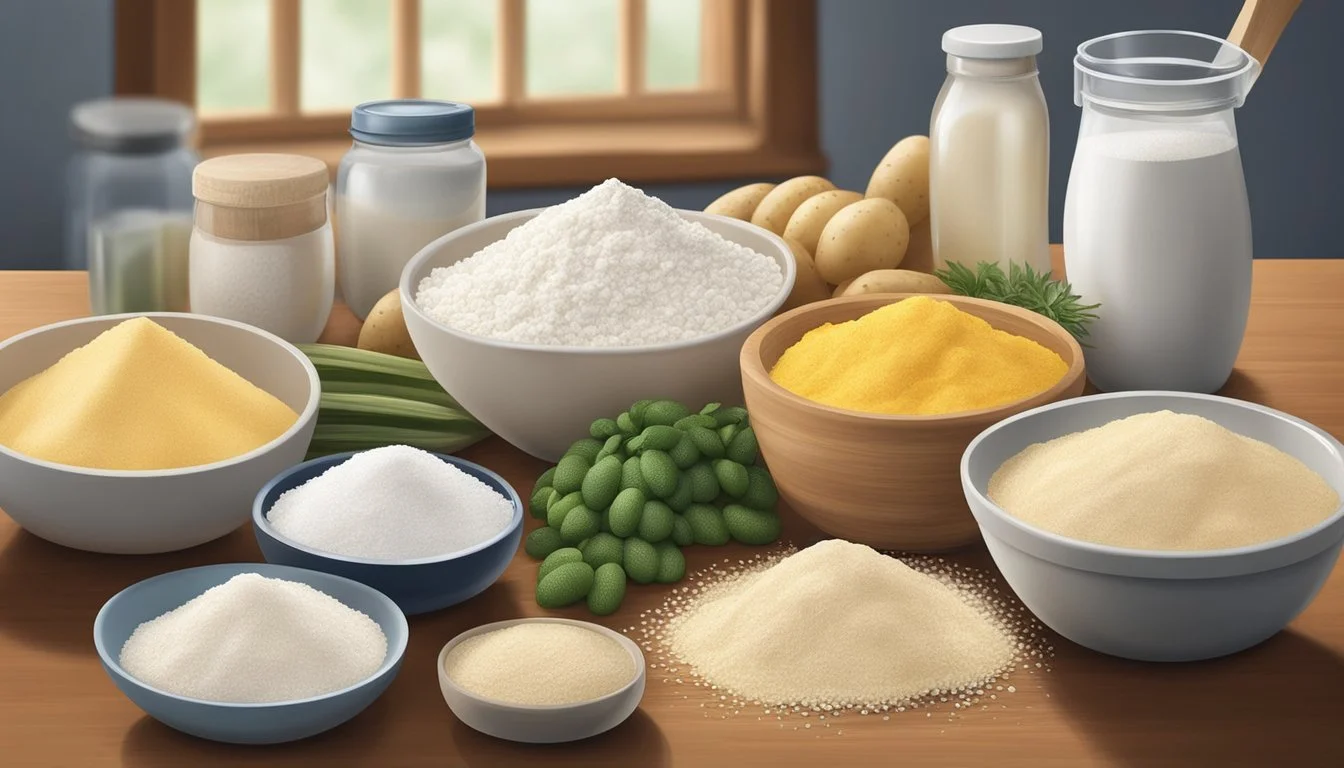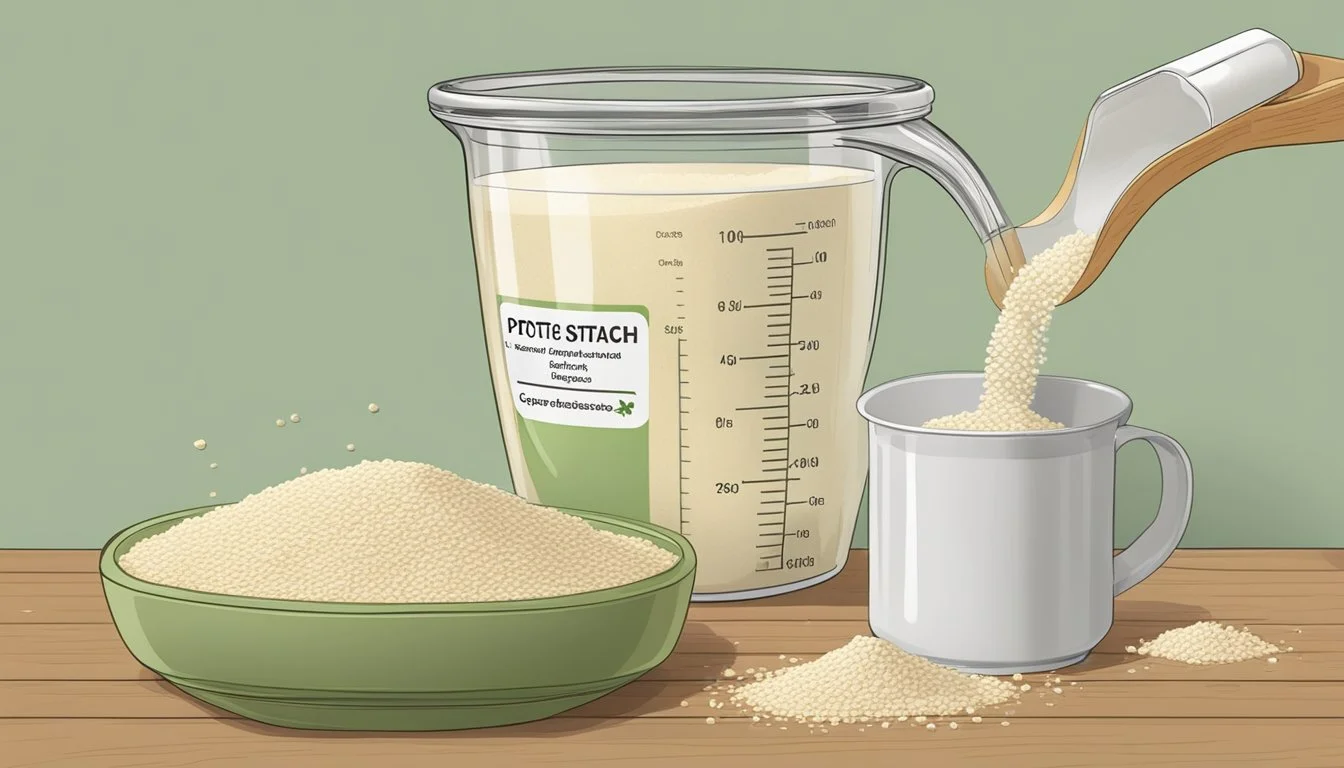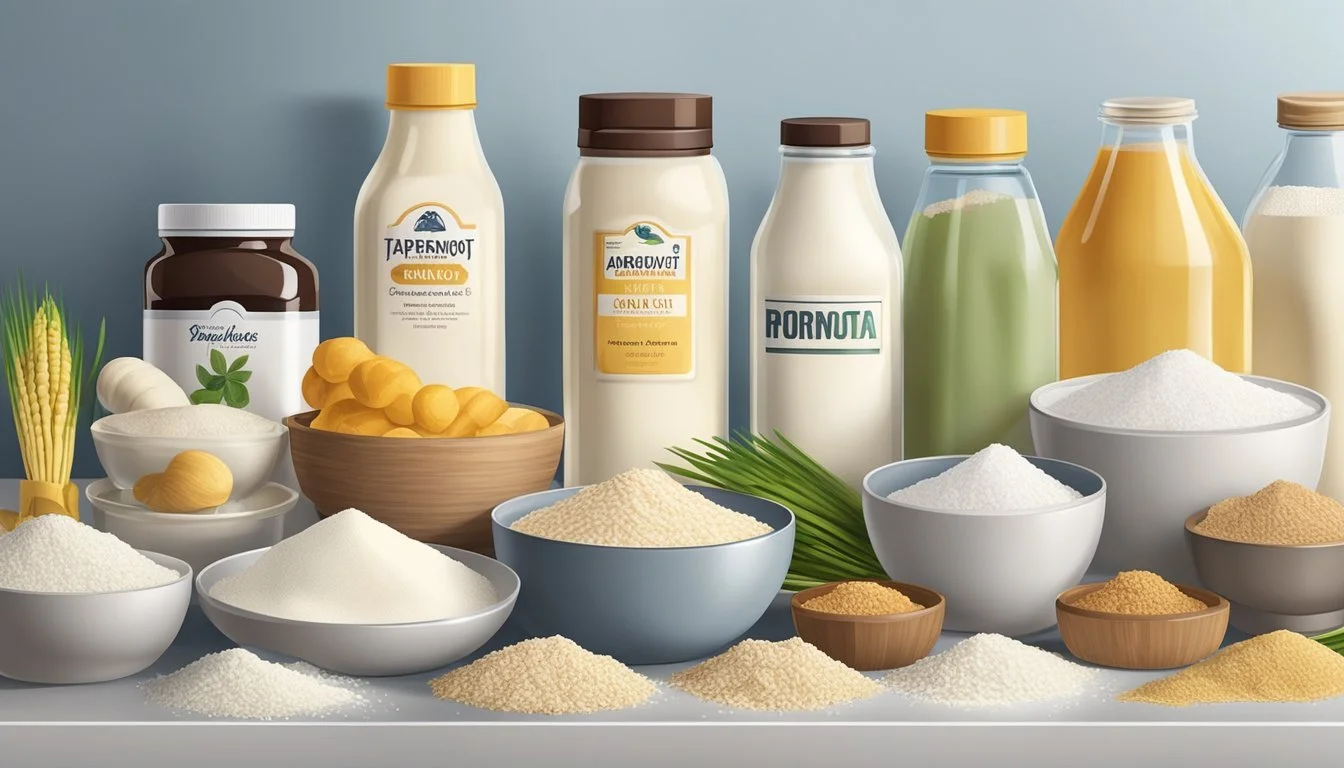Potato Starch Substitutes
Top Alternatives for Your Recipes
Potato starch is a versatile ingredient widely appreciated for its ability to thicken soups, sauces, and baked goods. However, there are situations when one might need to seek a substitute, whether due to dietary restrictions, health considerations, or simply running out of this staple in the middle of cooking. A variety of alternatives, each with unique properties, can stand in for potato starch, ensuring that the desired consistency and texture of a dish are maintained.
Cornstarch is a common go-to substitute, offering a similar thickening power and is often easily available in many kitchens. It's a suitable option especially for sauces and gravies, although it might impart a slightly different texture when compared to potato starch. Another popular alternative is tapioca starch, derived from the cassava root, which can serve as a thickener and is also ideal for individuals following a gluten-free diet. In baking, arrowroot starch is favored for its ability to create a light and airy texture, much like potato starch, while also being gluten-free.
Understanding these substitutes for potato starch not only expands one's culinary toolbox but also caters to a broader range of dietary needs. Each substitute brings a unique quality to the table, and the choice among them can be tailored to enhance the dish being prepared while adhering to the specific requirements or preferences of the cook or diners.
Understanding Potato Starch
Potato Starch is a versatile carbohydrate derived from potatoes, (What wine goes well with potatoes?) serving as a key ingredient in various culinary applications due to its unique properties. It's particularly valued for its ability to thicken, its neutral taste, and its usefulness in gluten-free baking.
Properties and Uses in Cooking
Potato starch is prized for its neutral taste and fine, powdery texture, which makes it an excellent thickening agent in cooking. It's commonly used in:
Sauces and gravies for a smooth consistency
Soups as a clear thickener
Baking, to create moist, tender products
Unlike some other thickeners, potato starch provides a translucent finish to dishes, maintaining the integrity of clear sauces and soups.
Health Benefits and Nutritional Value
From a nutritional perspective, potato starch contains minimal protein and fat. It is primarily composed of carbohydrates, specifically resistant starch, which has the following benefits:
Feeds beneficial gut bacteria
May improve insulin sensitivity
However, it's important to note that potato starch should be consumed in moderation within a balanced diet.
Role in Gluten-Free Baking
In gluten-free baking, potato starch is a cornerstone ingredient because it helps replicate the texture that gluten provides. Its role includes:
Contributing to the lightness and fluffiness of baked goods
Serving as a binding agent in the absence of gluten
Potato starch's inability to form gluten makes it ideal for those with gluten sensitivities or celiac disease, allowing them to enjoy baked products without adverse health effects.
Common Potato Starch Substitutes
When cooking or baking, especially for those with Celiac Disease or gluten sensitivities, finding the right substitute for potato starch can be crucial. Here are four common alternatives that can be used across a variety of dishes with their distinct characteristics tailored to different culinary needs.
Cornstarch and Its Cooking Behavior
Cornstarch is a popular thickener with a behavior similar to potato starch. It's a go-to substitute in a 1:1 ratio for sauces and gravies. However, it's important to note that cornstarch can impart a slightly glossy finish to dishes, making it noticeable in the final presentation.
Rice Flour in Baking and Sauces
For a gluten-free cooking option that supports Celiac Disease diets, Rice Flour steps in effectively. It contributes a grainier texture and is excellent for baking and sauce preparation. Rice flour can replace potato starch in a 1:1 ratio, but it tends to absorb more liquid, so the liquid content in recipes may need to be adjusted.
Tapioca Starch for Binding and Thickening
Tapioca Starch is derived from the cassava root and is noted for its ability to bind and thicken. It's an alternative that has a similar neutral flavor to potato starch, making it an excellent choice for both savory and sweet dishes. Tapioca starch generally works in a 1:1 substitute ratio, offering a chewy and crisp texture in baking.
Arrowroot as a Neutral Flavor Thickener
Arrowroot is highly valued for its neutral flavor and gluten-free properties. It can replace potato starch in a ratio of 2 teaspoons of arrowroot to 1 tablespoon of potato starch. Particularly useful in acidic dishes, arrowroot is resistant to thinning and provides a smooth consistency without affecting the dish's inherent flavors.
Specialty Starch Substitutes
When considering alternatives to potato starch for baking and cooking, specialty starch substitutes not only serve as thickeners but also enrich recipes with nutrients. They offer a range of health benefits, including added fiber, protein, and healthy fats, and often cater to gluten-free requirements.
Coconut Flour for Healthy Fats and Fiber
Coconut Flour is a gluten-free alternative made from dried and ground coconut meat. It stands out for its high fiber content and healthy fats, making it a nutritious thickening agent. In recipes, it's advised to use a smaller quantity of coconut flour due to its high absorbency, typically a ratio of 1:4 compared to potato starch, along with an additional liquid.
Almond Flour's Protein-Rich Profile
Almond Flour, made by grinding blanched almonds, is rich in protein and healthy fats. As a potato starch substitute, it provides a slightly nutty flavor and a protein boost to recipes. Typically, almond flour requires a direct 1:1 replacement ratio, but its fat content can add moisture, so adjustments in liquid ingredients may be necessary.
Quinoa Flour: A Protein and Fiber Powerhouse
Another gluten-free alternative is Quinoa Flour, which is ground quinoa seeds. It is renowned for its high protein and fiber content, alongside essential amino acids and nutrients. Quinoa flour can usually replace potato starch in a 2:1 ratio, with adjustments for its earthier taste and denser texture.
Using Other Flours: Oat, Chickpea, and More
For those seeking diversity in their flour substitutes:
Oat Flour: Offers a neutral taste and is a rich source of fiber.
Chickpea Flour: Delivers a protein punch and works well in savory dishes.
These flours are generally used in a 1:1 ratio when substituting potato starch, but due to variances in density and texture, one might need to tweak the recipe for optimal results.
Cooking Techniques with Substitutes
When incorporating potato starch substitutes into cooking, one needs a keen understanding of how liquid ratios, texture achievement, and baking adjustments differ with each alternative. These aspects are critical to the success of the intended dish or baked good, ensuring flavor and consistency are maintained.
Adjusting Liquid Ratios in Recipes
Substitutes like wheat flour or instant mashed potato absorb liquids differently compared to potato starch. These alternatives require careful adjustments to the liquid content of recipes to prevent dishes from becoming too dry or too wet.
For wheat flour, often double the amount of potato starch is needed, and additional liquid may be necessary.
When using instant mashed potato, a 1:1 substitution generally works well, but one should consider the additional flavor and texture it introduces.
Techniques for Achieving Desired Texture
Texture is paramount in cooking and baking, and each substitute imparts its own qualities to a dish.
Arrowroot flour, as a potato starch substitute, is gluten-free like potato starch and provides a similar silky and clear thickening quality for sauces and soups.
In gluten-free baking, water chestnut flour can be a viable substitute, offering a texture similar to potato starch but with a slightly nutty flavor.
One should experiment with small quantities to perfect the texture in recipes when substituting potato starch.
Baking Adjustments for Altitude and Humidity
To achieve the intended results while baking at different altitudes or in varying humidity levels, substitutions need to be precise.
Baking with substitutes like wheat flour at high altitude may require additional flour or less baking powder and liquid due to the faster evaporation at higher elevations.
In high humidity, absorbent substitutes like instant mashed potato flakes can help maintain the structure in baked goods.
Precise measurement and slight modifications ensure that the alternative starch behaves as expected in any climate.
Considerations for Dietary Restrictions
Choosing a potato starch substitute often depends on dietary restrictions, requiring careful selection to accommodate needs such as gluten-free diets, specific food allergies, or vegan lifestyles.
Gluten-Free Needs and Alternatives
Individuals with celiac disease or gluten intolerance must opt for gluten-free thickening agents. Potato starch itself is naturally gluten-free, which makes it ideal for gluten-free cooking. However, for those needing alternatives, options like cornstarch and arrowroot are comparable substitutes, both in effect and gluten-free status.
Cornstarch: A go-to thickener for sauces and soups, used in a 1:1 substitution ratio.
Arrowroot: Works well for acidic foods and freezes better than cornstarch, with a similar substitution rate.
Allergies and Grain-Free Options
For those with grain allergies or following a grain-free diet, options like coconut flour or almond flour can serve as substitutes, though they are not direct one-to-one replacements due to higher absorption rates. Coconut flour pairs well as a thickener in baked goods when increased liquid is added.
Coconut Flour: Requires an adjustment to the liquid content in recipes.
Almond Flour: Offers a nutty flavor and is used in dense, moist baked goods.
Vegan Substitutes for Potato Starch
Vegan cooks often seek substitutes that do not compromise the ethical aspects of their diet. Xanthan gum stands out as an effective thickener for various vegan dishes, from dressings to soups. It's potent, so a small amount is sufficient.
Xanthan Gum: A tiny pinch can thicken an entire sauce batch, ensuring potency without altering flavor.
Potato Starch Substitute Applications
When replacing potato starch in recipes, understanding how different substitutes work in various applications is crucial to maintain the desired texture and consistency.
Making Baked Goods with Substitutes
In baking, all-purpose flour or wheat flour can replace potato starch; however, double the amount of flour is often required to achieve the same effect. Cornstarch tends to work as a 1:1 substitute and offers a light texture, suitable for cakes and pastries. For a gluten-free option, sweet rice flour or almond flour may also serve as alternatives, both adding a distinct but pleasant texture to the final product.
Thickening Soups and Sauces Effectively
For thickening soups and sauces, cornstarch acts as a direct substitute for potato starch in equal ratios, providing a glossy finish and smooth texture. Likewise, arrowroot flour or tapioca starch are excellent choices, giving a clear and thick consistency without altering the taste. They must be mixed with a cold liquid before being added to the dish to prevent clumping. Here's a summarized guide:
Cornstarch: Use 1:1 in place of potato starch.
Arrowroot: Use 1:1, mix with cold liquid first.
Tapioca Starch: Use 1:1, mix with cold liquid first.
Substitutes in Frying and Coating Foods
For a crispy coating on fried foods, wheat flour can be used as a substitute. A pre-mixture in a food processor can help achieve a fine and even consistency for better adherence to the food. Cornstarch, often combined with flour, provides a crispy texture once fried. Tapioca starch also serves as a suitable alternative, yielding a light and crispy exterior when used in batter recipes.
The Culinary Impact of Substitutes
When seeking potato starch substitutes, one should consider how alternatives may alter taste, texture, and the integrity of traditional flavors in culinary applications.
Taste Variations with Different Substitutes
Substitutes such as wheat flour and arrowroot can introduce subtle flavor differences in dishes. Wheat flour, being slightly nutty and hearty, may change the taste profile of lighter foods. Arrowroot, in contrast, is very neutral in flavor, making it an excellent choice for maintaining the original taste of a dish.
Texture Comparison in Cooking and Baking
The choice of substitute significantly affects the texture of both cooked and baked goods. Substitutes like cornstarch and arrowroot powder offer a similar texture to potato starch, thickening without imparting cloudiness. They are often used in a 1:1 ratio for simplicity. However, wheat flour leads to a less transparent, occasionally heavier, consistency and may require varying quantities to achieve the desired thickness.
Preserving Traditional Flavors
Preserving the authenticity of certain traditional dishes can be challenging when substituting ingredients. For culinary uses requiring a neutral base, such as gravies and sauces, using cornstarch prevents the alteration of expected flavors. It's essential to select a substitute that complements the food's original taste profile when baking or cooking specific recipes.
Storage and Shelf Life of Substitutes
When choosing a substitute for potato starch, understanding the optimal storage conditions and expected shelf life ensures maximum freshness and efficacy in cooking. This knowledge is particularly important as substitutes differ in moisture content and nutrient composition.
Optimizing Storage for Longevity
To extend the shelf life of potato starch substitutes, storage should occur in a cool, dry place away from direct sunlight. Moisture is a primary enemy, as it can lead to spoilage and a decrease in quality. Keep products in airtight containers to protect them from humidity and potential contaminants. Here's an overview for common substitutes:
All-purpose flour: Typically lasts up to 8 months when stored properly.
Tapioca Starch: Can maintain quality for 6 months to 1 year.
Rice Flour: Has a similar shelf life to all-purpose flour, prolongable by refrigeration.
Oat Flour: Best used within 3 months, refrigeration can extend its life.
Monitoring Quality and Freshness
Substitutes must be regularly checked for freshness, as their nutritional benefits, such as proteins, fibers, and carbohydrates, may degrade over time.
Signs of degradation include:
Clumping from moisture absorption.
Off-smells indicating potential spoilage.
Discoloration or presence of pests.
Nutrient breakdown:
Substitute Calories Carbohydrates Proteins Fibers All-purpose flour Varies High Moderate Low Tapioca Starch Low High Negligible Negligible Rice Flour Varies High Low Low Oat Flour Higher Moderate to High Moderate to High High
Maintaining a consistent evaluation of these signs and a good storage routine promotes longevity and quality in your choice of potato starch substitutes.





